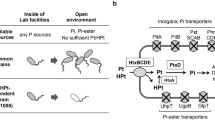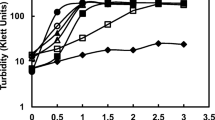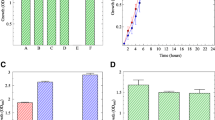Abstract
When Escherichia coli cells were grown in media containing either phosphite or hypophosphite as the sole source of phosphorus, they responded to this situation primarily in the same way as phosphatelimited cultures: The activity of alkaline phosphatase increased drastically, which under natural conditions would enable the cells to compklensatae for the shortage increased drastically, which under natural conditions would enable the cells to compensate for the shortage of phosphate. Subsequent transfers, however, resulted in a quite different response: While the phosphatase activity of phosphate-limited cells stays at a high derepressed level, its increase was followed by a gradual decline in organisms grown on phosphite or hypophosphite. After eight to ten transfers on these P-compounds, phosphatase activity was back to its initial, repressed, low level, indicating that the cells were fully adapted to these substrates. Adaptation to either PO 3-3 or PO 3-2 was completely abolished if the cells were again grown with PO 3-4 as P-source, whereafter the entire process of adaptation had to be repeated. The observed adaptation pattern, reflected by the alterations of phosphatase activity, was qualitatively equal with PO 3-3 and PO 3-2 , but quantitatively different, because the response to hypophosphite gave much higher values than the increase obtained with phosphite.
Phosphite-adapted cells are not simultaneously adapted to hypophosphite, but their response to the latter was less intense than observed after direct transfers from PO 3-4 to PO 3-2 . Adaptation to hypophosphite, however, led simultaneously to phosphite adaptation, so that these cells can utilize both P-compounds as a substitute for phosphate.
Similar content being viewed by others
References
Adams, F., Conrad, J. P.: Transition of phosphite to phosphate in soils. Soil Sci. 75, 361–371 (1953)
Cashel, M., Freese, E.: Excretion of alkaline phosphatase by Bacillus subtilis. Biochem. biophys. Res. Commun. 16, 541–544 (1964)
Casida, L. E.: Microbial oxidation and utilization of orthophosphite during growth. J. Bact. 80, 237–241 (1960)
Heinen, W., Lauwers, A. M.: Hypophosphite oxidase from Bacillus caldolyticus. Arch. Microbiol. 95, 267–274 (1974)
Malacinski, G. M., Konetzka, W. A.: Bacterial oxidation of orthophosphite. J. Bact. 91, 578–582 (1966)
Malacinski, G. M., Konetzka, W. A.: Orthophosphite-nicotinamide adenine dinucleotide oxidoreductase from Pseudomonas fluorescens. J. Bact. 93, 1906–1910 (1967)
Torriani, A.: Influence of inorganic phosphate in the formation of phosphatase by Escherichia coli. Biochim. biophys. Acta (Amst.) 38, 460–479 (1960)
Author information
Authors and Affiliations
Rights and permissions
About this article
Cite this article
Lauwers, A.M., Heinen, W. Alterations of alkaline phosphatase activity during adaptation of Escherichia coli to phosphite and hypophosphite. Arch. Microbiol. 112, 103–107 (1977). https://doi.org/10.1007/BF00446661
Received:
Issue Date:
DOI: https://doi.org/10.1007/BF00446661




